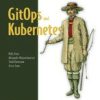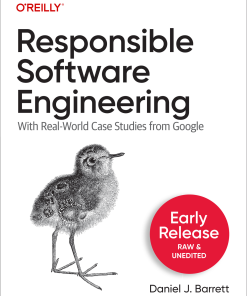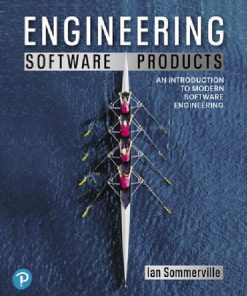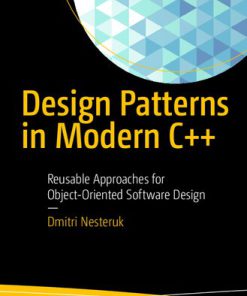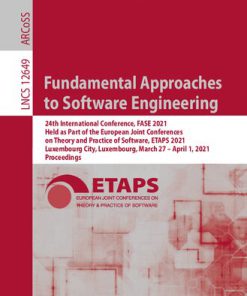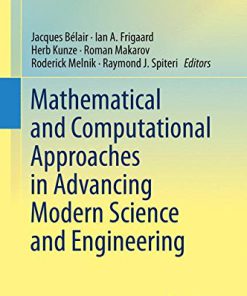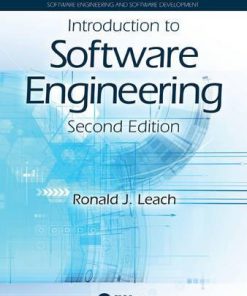Software Engineering Modern Approaches 2nd edition by Eric Braude,Michael Bernstein 9781478632306 1478632305
$50.00 Original price was: $50.00.$25.00Current price is: $25.00.
Software Engineering Modern Approaches 2nd edition by Eric Braude,Michael Bernstein- Ebook PDF Instant Download/Delivery: 9781478632306,1478632305
Full download Software Engineering Modern Approaches 2nd edition after payment
Product details:
ISBN 10:1478632305
ISBN 13: 9781478632306
Author:Eric Braude,Michael Bernstein
Today’s software engineer must be able to employ more than one kind of software process, ranging from agile methodologies to the waterfall process, from highly integrated tool suites to refactoring and loosely coupled tool sets. Braude and Bernstein’s thorough coverage of software engineering perfect the reader’s ability to efficiently create reliable software systems, designed to meet the needs of a variety of customers.
Topical highlights
• Process: concentrates on how applications are planned and developed
• Design: teaches software engineering primarily as a requirements-to-design activity
• Programming and agile methods: encourages software engineering as a code-oriented activity
• Theory and principles: focuses on foundations
• Hands-on projects and case studies: utilizes active team or individual project examples to facilitate understanding theory, principles, and practice
In addition to knowledge of the tools and techniques available to software engineers, readers will grasp the ability to interact with customers, participate in multiple software processes, and express requirements clearly in a variety of ways. They will have the ability to create designs flexible enough for complex, changing environments, and deliver the proper products.
Software Engineering Modern Approaches 2nd Table of contents:
PART I: Introduction to Software Engineering
Chapter 1: The Goals and Terminology of Software Engineering
1.1 What is Software Engineering
1.2 Why Software Engineering Is Critical: Software Disasters
1.2.1 The Virtual Case File Project
1.2.2 The Ariane project
1.2.3 Radiation Overdose
1.2.4 More Software Disasters
1.3 Why Software Fails or Succeeds
1.4 Software Engineering Activities
1.4.1 People
1.4.2 Product
1.4.3 Project
1.4.4 Process
1.5 Software Engineering Principles
1.6 Ethics in Software Engineering
1.7 Case Studies
1.8 Summary
1.9 Exercises
Bibliography
Chapter 2: Introduction to Quality and Metrics in Software Engineering
2.1 The Meaning of Software Quality
2.2 Defects in Software
2.3 Verification and Validation
2.4 Planning for Quality
2.5 Metrics
2.5.1 Quality Metrics
2.6 Summary
2.7 Exercises
Bibliography
PART II: Software Process
Chapter 3: Software Process
3.1 The Activities of Software Process
3.2 Software Process Models
3.2.1 The Waterfall Process Model
3.2.2 Iterative and Incremental Development
3.2.3 Prototyping, Feasibility Studies, and Proofs of Concept
3.2.4 Spiral Model
3.2.5 Unified Process and the Rational Unified Process
3.2.6 Agile Processes
3.2.7 Open-Source Processes
3.3 Case Study: Student Team Guidance
3.3.1 Team Guidance-Initial Team Meeting
3.3.2 Team Guidance-Communication Plan
3.3.3 Team Guidance-Test Communication Plan
3.4 Summary
3.5 Exercises
Bibliography
Chapter 4: Agile Software Processes
4.1 Agile History and Agile Manifesto
4.2 Agile Principles
4.3 Agile Methods
4.4 Agile Processes
4.4.1 Extreme Programming
4.4.2 Scrum
4.4.3 Crystal
4.5 Integrating Agile with Non-Agile Processes
4.5.1 A Non-Agile-Driven Approach
4.5.2 An Agile-Driven Approach
4.6 Summary
4.7 Exercises
Bibliography
Chapter 5: Quality in the Software Process
5.1 Principles of Managing Quality
5.2 Managing Quality in Agile Processes
5.3 Quality Planning
5.3.1 Software Quality Assurance Plan
5.3.2 IEEE Quality Documents
5.4 Inspections
5.4.1 Inspection Principles
5.4.2 Inspection Process
5.5 QA Reviews and Audits
5.6 Defect Management
5.6.1 Classifying Defects
5.6.2 Tracking Defects
5.7 Process Improvement and Process Metrics
5.8 Organization-Level Quality and the CMMI
5.8.1 Level 1: Initial
5.8.2 Level 2: Managed
5.8.3 Level 3: Defined
5.8.4 Level 4: Quantitatively Managed
5.8.5 Level 5: Optimizing
5.8.6 Relationship of the CMMI to the PSP, TSP
5.8.7 Relationship of the CMMI to Agile Methods
5.9 Case Study: Software Quality Assurance Plan for Encounter
5.10 Summary
5.11 Exercises
Bibliography
Chapter 6: Software Configuration Management
6.1 Software Configuration Management Goals
6.2 SCM Activities
6.2.1 Configuration Identification
6.2.2 Baselines
6.2.3 Change Control
6.2.4 Version Control
6.2.5 Configuration Audits
6.2.6 Configuration Status Reporting
6.2.7 Release Management and Delivery
6.3 Configuration Management Plans
6.4 Configuration Management Systems
6.4.1 Concurrent Version System (CVS)
6.5 Case Study: Encounter Video Game
6.6 Case Study: Eclipse
6.7 Student Team Guidance: Configuration Management
6.8 Summary
6.9 Exercises
Bibliography
PART III: Project Management
Chapter 7: Principles of Software Project Management I: Organization, Tools, and Risk Management
7.1 Software Project Organization
7.1.1 Project-Oriented Organization
7.1.2 Function-Oriented Organization
7.1.3 Matrix Organization
7.1.4 Agile Organization
7.2 Team Size
7.3 Geographically Distributed Development
7.4 The Team Software Process
7.4.1 Introductory Team Software Process (TSPi)
7.5 Software Project Tools and Techniques
7.5.1 Tool Selection
7.5.2 Build or Buy Decisions
7.5.3 Language Selection
7.5.4 Decision Making with Triage
7.5.5 Project Variables
7.6 Risk Management
7.7 Student Team Guidance: Organizing the Software Project’s Management
7.7.1 Team Guidance-Student Team Organization
7.7.2 Team Guidance-Team Meetings
7.8 Summary
7.9 Exercises
Bibliography
Chapter 8: Principles of Software Project Management II: Estimation, Scheduling, and Planning
8.1 Cost Estimation
8.1.1 Estimate Precision
8.1.2 Estimation Methods
8.1.3 Estimating Lines of Code without Function Points
8.1.4 Function Points
8.1.5 Estimating Effort and Duration from Lines of Code
8.1.6 Assessments for Agile Projects: Story Points and Velocity
8.2 Scheduling
8.3 The Software Project Management Plan
8.4 Case Study: Encounter Project Management Plan
8.5 Case Study: Project Management in Eclipse
8.6 Case Study: Project Management for Open Office
8.7 Case Study: Student Team Guidance
8.8 Summary
8.9 Exercises
Bibliography
Chapter 9: Quality and Metrics in Project Management
9.1 Cultivating and Planning Internal Quality
9.2 Project Metrics
9.2.1 Identification
9.2.2 Planning
9.2.3 Monitor and Review
9.3 Using Metrics for Improvement
9.3.1 Improvement within a Project
9.3.2 Improvement across Projects
9.4 Software Verification and Validation Plan
9.5 Case Study: Software Verification and Validation Plan for Encounter
9.6 Summary
9.7 Exercises
Bibliography
PART IV: Requirement Analysis
Chapter 10: Principles of Requirements Analysis
10.1 The Value of Requirements Analysis
10.2 Sources of Requirements
10.3 High-Level vs. Detailed Requirements
10.4 Types of Requirements
10.4.1 Functional Requirements
10.5 Nonfunctional Requirements
10.5.1 Quality Attributes
10.5.2 Constraints
10.5.3 External Interface Requirements
10.5.4 User Interface Requirements: Principles
10.5.5 Error-Handling Requirements
10.6 Documenting Requirements
10.7 Traceability
10.8 Agile Methods and Requirements
10.9 Updating the Project to Reflect Requirements Analysis
10.10 Summary
10.11 Exercises
Bibliography
Chapter 11: Analyzing High-Level Requirements
11.1 Examples of Customer Wants
11.2 Stakeholder Vision
11.3 The Interview and Documentation Process
11.4 Writing an Overview
11.5 Describing Main Functions and Use Cases
11.6 Agile Methods for High-Level Requirements
11.7 Specifying User Interfaces: High Level
11.7.1 Step 1: Know Your User
11.7.2 Step 2: Understand the Business Function
11.7.3 GUI Transitions
11.8 Security Requirements
11.9 Using Diagrams for High-Level Requirement
11.9.1 Data Flow Diagrams
11.9.2 State Transition Diagrams
11.10 Case Study: High-Level Software Requirements Specification (SRS) for the Encounter Video Game
11.11 Case Study: High-Level Requirements for Eclipse
11.12 Eclipse Platform Subproject (First of Three)
11.13 Case Study: High-Level Requirements for OpenOffice
11.14 Summary
11.15 Exercises
Bibliography
Chapter 12: Analyzing Detailed Requirements
12.1 The Meaning of Detailed Requirements
12.2 Organizing Detailed Requirements
12.2.1 Organizing Detailed Requirements by Feature
12.2.2 Organizing Detailed Requirements by Use Case
12.2.3 Organizing Detailed Requirement by GUI
12.2.4 Organizing Detailed Requirements by State
12.2.5 Organizing Requirements by Class
12.2.6 Classification Methods: Advantages and Disadvantages
12.3 User Interfaces: Detailed Requirements
12.4 Detailed Security Requirements
12.5 Error Conditions
12.6 Traceability of Detailed Requirements
12.7 Using Detailed Requirements to Manage Projects
12.8 Prioritizing Requirements
12.9 Associating Requirements with Tests
12.10 Agile Methods for Detailed Requirements
12.11 Using Tools and the Web for Requirements Analysis
12.11.1 Simple Projects
12.11.2 IBM’s RequisitePro
12.12 The Effects on Projects of the Detailed Requirements Process
12.13 Student Project Guide: Requirements for the Encounter Case Study
12.14 Case Study: Detailed Requirements for the Encounter Video Game
12.15 Summary
12.16 Exercises
Bibliography
Chapter 13: Quality and Metrics in Requirements Analysis
13.1 Quality of Requirements for Agile Projects
13.2 Accessibility of Requirements
13.3 Comprehensiveness of Requirements
13.4 Understandability of Requirements
13.5 Unambiguity of Requirements
13.6 Consistency of Requirements
13.7 Prioritization of Requirements
13.8 Security and High-Level Requirements
13.9 Self-Completeness of Requirements
13.10 Testability of Requirements
13.11 Traceability of Requirements
13.12 Metrics for Requirements Analysis
13.13 Inspecting Detailed Requirements
13.14 Summary
13.15 Exercises
Chapter 14: Formal and Emerging Methods in Requirements Analysis: An Introduction (Online Chapter)
PART V: Software Design
Chapter 15: Principles of Software Design
15.1 The Goals of Software Design
15.2 Integrating Design Models
15.2.1 Use Case Model
15.2.2 Class Models
15.2.3 Data Flow Models
15.2.4 State Models
15.3 Frameworks
15.4 IEEE Standards for Expressing Designs
15.5 Summary
15.6 Exercises
Chapter 16: The Unified Modeling Language
16.1 Classes in UML
16.2 Class Relationships in UML
16.2.1 Packages
16.2.2 Associations
16.3 Multiplicity
16.4 Inheritance
16.4.1 Aggregation
16.4.2 Composition
16.4.3 Dependency
16.4.4 Class Diagrams
16.4.5 Object Diagrams
16.5 Sequence Diagrams
16.6 State Diagrams
16.6.1 States and Substates
16.6.2 Events
16.6.3 Transitions
16.6.4 OnlineShopper State Diagram Example
16.6.5 The Relationship between States and GUls
16.7 Activity Diagrams
16.8 Data Flow Models
16.9 A Design Example with UML
16.10 Summary
16.11 Exercises
Bibliography
Chaper 17: Software Design Patterns
17.1 Examples of a Recurring Design Purpose
17.1.1 A Simple Example
17.1.2 A More Complex Example
17.2 An Introduction to Design Patterns
17.2.1 Example Application: Without Applying Design Patterns
17.2.2 Example Application: Applying a Design Pattern
17.3 Summary of Design Patterns by Type: Creational, Structural, and Behavioral
17.3.1 Creational Design Patterns
17.3.2 Structural Design Patterns
17.3.3 Behavioral Design Patterns
17.4 Characteristics of Design Patterns: Viewpoints, Roles, and Levels
17.4.1 Two Viewpoints for Describing a Pattern: Static and Dynamic
17.4.2 Two Layers of a Pattern: Abstract and Concrete
17.4.3 Three Roles Involved in Pattern Usage: Pattern Application, Client, and Setup
17.5 Selected Creational Design Patterns
17.5.1 Singleton
17.5.2 Abstract Factory
17.6 Selected Structural Design Patterns
17.6.1 Facade: Interfacing with a Collection of Classes
17.6.2 Adapter: Interfacing in a Flexible Manner
17.7 Selected Behavioral Design Patterns
17.7.1 Interpreter: Parsing Expressions
17.7.2 Observer
17.7.3 State
17.8 Design Pattern Forms: Delegation and Recursion
17.8.1 The Delegation Design Pattern Form
17.8.2 The Recursion Design Pattern Form
17.9 Summary
17.10 Exercises
Bibliography
Chapter 18: Software Architecture
18.1 A Categorization of Architectures
18.2 Software Architecture Alternatives and Their Class Models
18.2.1 Data Flow Architectures
18.2.2 Independent Components
18.2.3 Virtual Machines
18.2.4 Repository Architectures
18.2.5 Layered Architectures
18.2.6 Service-Oriented Architectures
18.2.7 Using Multiple Architectures within an Application
18.3 Trading Off Architecture Alternatives
18.4 Tools for Architectures
18.5 IEEE Standards for Expressing Designs
18.6 Effects of Architecture Selection on the Project Plan
18.7 Case Study: Preparing to Design Encounter (Student Project Guide continued)
18.8 Case Study: Software Design Document for the Role-Playing Video Game Framework
18.9 Case Study: Software Design Document for Encounter (Uses the Framework)
18.10 Case Study: Architecture of Eclipse
18.11 Case Study: OpenOffice Architecture
18.12 Summary
18.13 Exercises
Bibliography
Chapter 19: Detailed Design
19.1 Relating Use Cases, Architecture, and Detailed Design
19.2 A Typical Road Map for the “Detailed Design” Process
19.3 Object-Oriented Design Principles
19.4 Designing against Interfaces
19.5 Specifying Classes, Functions, and Algorithms
19.5.1 Preconditions, Postconditions, and Invariants
19.5.2 Expressing Algorithms with Activity Diagrams and Pseudocode
19.6 Reusing Components
19.7 Sequence and Data Flow Diagrams for Detailed Design
19.7.1 Detailed Sequence Diagrams
19.7.2 Detailed Data Flow Diagrams
19.8 Detailed Design and Agile Processes
19.9 Design in the Unified Development Process
19.10 IEEE Standard 890 for Detailed Design
19.11 Updating a Project with Detailed Design
19.12 Case Study: Detailed Design of Encounter
19.13 Case Study: Detailed Design of Eclipse
19.14 Summary
19.15 Exercises
Bibliography
Chapter 20: Design Quality and Metrics
20.1 Degree of Understandability, Cohesion, and Coupling
20.2 Degree of Sufficiency as a Quality Goal
20.3 Degree of Robustness as a Quality Goal
20.4 Degree of Flexibility as a Design Quality Goal
20.5 Degree of Reusability as a Design Quality Goal
20.6 Degree of Time Efficiency as a Design Quality Measure
20.7 Degree of Space Efficiency as a Design Quality Measure
20.8 Degree of Reliability as a Design Quality Measure
20.9 Degree of Security as a Design Quality Measure
20.10 Assessing Quality in Architecture Selection
20.10.1 Metrics for Architecture Quality
20.10.2 Choosing an Architecture among Alternatives
20.10.3 Verifying Architectures
20.11 Assessing the Quality of Detailed Designs
20.11.1 Techniques for Assessing the Quality of Detailed Designs
20.11.2 Metrics for Detailed Design
20.11.3 Inspection of Detailed Designs
20.12 Summary
20.13 Exercises
Bibliography
Chapter 21: Advanced and Emerging Methods in Software Design (Online Chapter)
PART VI: Implementation
Chapter 22: Principles of Implementation
22.1 Agile and Non-Agile Approaches to Implementation
22.2 Choosing a Programming Language
22.3 Identifying Classes
22.4 Defining Methods
22.5 Implementation Practices
22.5.1 Use Expressive Naming
22.5.2 Global Variables
22.5.3 Function Parameters
22.5.4 Explicit Numbers
22.5.5 Initialization and Declaration
22.5.6 Loops
22.6 Defensive Programming
22.6.1 Error Handling
22.6.2 Exception Handling
22.6.3 Buffer Overflow Prevention
22.6.4 “Enforce Intentions”
22.7 Coding Standards
22.7.1 Naming Conventions
22.7.2 Other Conventions
22.8 Comments
22.8.1 Documenting Attributes
22.9 Tools and Environments for Programming
22.10 Case Study: Encounter Implementation
22.11 Case Study: Eclipse
22.12 Case Study: OpenOffice
22.13 Student Team Guidance for Implementation
22.14 Summary
22.15 Code Listings Referred to in this Chapter
22.15.1 Code Listing for Video Rental Example
22.15.2 Code Listing for Encounter Character
22.16 Exercises
Bibliography
Chapter 23: Quality and Metrics in Implementation
23.1 Quality of Implementation
23.1.1 The Sufficiency of an Implementation
23.1.2 The Robustness of an Implementation
23.1.3 The Flexibility of an Implementation
23.1.4 The Reusability of an Implementation
23.1.5 The Efficiency of an Implementation
23.1.6 The Reliability of an Implementation
23.1.7 The Scalability of an Implementation
23.1.8 The Degree of Security of an Implementation
23.2 Code Inspections and Related Quality Procedures
23.2.1 Code Walkthroughs and Code Reviews
23.2.2 Pair Programming
23.3 Summary
23.4 Exercises
Chapter 24: Refactoring
24.1 Big Refactorings
24.2 Composing Methods
24.3 Moving Features between Objects
24.4 Organizing Data
24.5 Generalization
24.6 Introducing Modules
24.7 Refactoring in Projects
24.7.1 Refactoring in the Agile Project Life Cycle
24.7.2 Refactoring and Design Patterns
24.8 Summary
24.9 Exercises
Bibliography
PART VII: Testing and Maintenance
Chapter 25: Introduction to Software Testing
25.1 Testing Early and Often; and the Agile Connection
25.2 Retesting: Regression Testing
25.3 Black Box and White Box Testing
25.4 Unit Testing vs. Post-Unit Testing
25.5 Testing Object-Oriented Implementations
25.6 Documenting Tests
25.7 Test Planning
25.7.1 Organize “Unit” vs. Non-Unit Tests
25.7.2 Determine the Extent of Testing
25.7.3 Decide How Tests Will Be Documented
25.7.4 Decide How and Where to Get Test Input
25.7.5 Decide Who Will Be Involved in Testing
25.7.6 Estimate the Resources Required
25.7.7 Arrange to Track Metrics
25.8 Testing Test Suites by Fault Injection
25.9 Summary
25.10 Exercises
Chapter 26: Unit Testing
26.1 The Sources of Units for Unit Testing
26.2 Unit Test Methods
26.2.1 Statement Coverage
26.2.2 Branch Coverage
26.2.3 Path Coverage
26.2.4 Equivalence Partitioning
26.2.5 Boundary Value Analysis
26.3 Testing Methods
26.3.1 Checklist for Testing Methods
26.3.2 Organizing Test Cases
26.3.3 Stubs
26.3.4 Example of a Method-Level Unit Test
26.4 Test-Driven Development
26.4.1 Using JUnit for Unit Testing
26.5 Case Study: Encounter Video Game
26.5.1 Code Listing for EncounterCharacter Class
26.5.2 Unit Tests for the EncounterCharacter Class
26.6 Summary
26.7 Exercises
Bibliography
Chapter 27: Module and Integration Testing
27.1 Stubs and Drivers
27.2 Testing a Class
27.2.1 Example of a Class Test
27.2.2 Attribute-Oriented Tests
27.2.3 Testing Class Invariants
27.2.4 State-Based Tests
27.3 Integration
27.3.1 Big Bang Integration
27.3.2 Incremental Integration
27.3.3 Bottom-Up Integration
27.3.4 Top-Down Integration
27.3.5 Sandwich Integration
27.3.6 Continuous Integration
27.4 Daily Builds
27.5 Interface Testing
27.6 Module Integration
27.7 Case Study: Class Test for Encounter
27.8 Case Study: Encounter Integration Plan
27.9 Summary
27.10 Exercises
Bibliography
Chapter 28: Testing at the System Level
28.1 Functional Testing
28.2 Nonfunctional Testing
28.2.1 Performance Testing
28.2.2 Load/Stress Event Testing
28.2.3 Reliability and Availability Testing
28.2.4 Recoverability Testing
28.2.5 Usability Testing
28.2.6 Security Testing
28.2.7 Compatibility Testing
28.2.8 Installation and Installability Testing
28.2.9 Serviceability Testing
28.3 Testing with Lightweight Requirements
28.3.1 Testing in the Absence of Requirements
28.3.2 Models for Software Testing
28.3.3 Constructing Directed Graphs for Black Box Testing
28.3.4 Using Directed Graphs in Testing
28.3.5 Testing for Agile Processes
28.3.6 Qualities of a Good Tester
28.4 Testing Shortly Before Release
28.4.1 Soak Testing
28.4.2 Acceptance Testing
28.4.3 Alpha and Beta Releases
28.5 Case Study: Encounter Software Test Documentation
28.6 Case Study: Eclipse
28.7 Case Study: OpenOffice
28.7.1 Open Contribution to Quality Assurance
28.7.2 Smoke Tests
28.7.3 OpenOffice QA Priorities
28.7.4 Automated Product Source Code QA
28.7.5 Automated GUI Testing
28.8 Summary
28.9 Exercises
Bibliography
Chapter 29: Software Maintenance
29.1 Types of Software Maintenance
29.1.1 Maintenance Requests
29.1.2 Corrective Maintenance
29.1.3 Adaptive Maintenance
29.1.4 Perfective Maintenance
29.1.5 Preventive Maintenance
29.2 Issues of Software Maintenance
29.2.1 Management Challenges
29.2.2 Process Challenges
29.2.3 Technical Issues
29.3 Maintenance Process
29.3.1 Root-Cause Analysis
29.3.2 Patch Releases
29.3.3 Software Trouble Reports, Maintenance Requests, and Correction Reports
29.4 IEEE Maintenance Standards
29.4.1 Maintenance Problem Identification
29.4.2 Maintenance Problem Analysis
29.4.3 Designing for a Maintenance Request
29.4.4 Implementing a Maintenance Request
29.5 Software Evolution
29.5.1 Reverse Engineering
29.5.2 Reengineering
29.6 Maintenance Metrics
29.7 Case Study
29.8 Summary
29.9 Exercises
People also search for Software Engineering Modern Approaches 2nd :
software modern architecture
what is software engineering approach
software engineering modern approaches 2nd edition
modern software engineering practices
software engineering modern approaches second edition
Tags:
Eric Braude,Michael Bernstein,Modern,Approaches,Engineering
You may also like…
Computers - Applications & Software
Engineering - Mechanical Engineering & Dynamics
Modern Mechanical Engineering Research Development and Education 1st Edition J. Paulo Davim
Computers - Programming
Computers - Programming
Computers - Programming
Fundamental Approaches to Software Engineering 1st Edition Esther Guerra
Computers - Computer Science
Computers - Programming
Introduction to Software Engineering 2nd Edition Ronald J. Leach
Engineering




